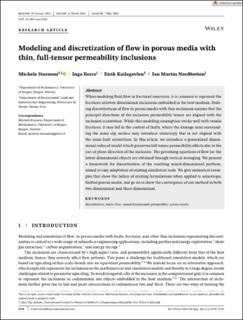| dc.contributor.author | Starnoni, Michele | |
| dc.contributor.author | Berre, Inga | |
| dc.contributor.author | Keilegavlen, Eirik | |
| dc.contributor.author | Nordbotten, Jan Martin | |
| dc.date.accessioned | 2022-02-02T10:32:12Z | |
| dc.date.available | 2022-02-02T10:32:12Z | |
| dc.date.created | 2022-01-24T14:33:17Z | |
| dc.date.issued | 2021 | |
| dc.identifier.issn | 0029-5981 | |
| dc.identifier.uri | https://hdl.handle.net/11250/2976623 | |
| dc.description.abstract | When modeling fluid flow in fractured reservoirs, it is common to represent the fractures as lower-dimensional inclusions embedded in the host medium. Existing discretizations of flow in porous media with thin inclusions assume that the principal directions of the inclusion permeability tensor are aligned with the inclusion orientation. While this modeling assumption works well with tensile fractures, it may fail in the context of faults, where the damage zone surrounding the main slip surface may introduce anisotropy that is not aligned with the main fault orientation. In this article, we introduce a generalized dimensional reduced model which preserves full-tensor permeability effects also in the out-of-plane direction of the inclusion. The governing equations of flow for the lower-dimensional objects are obtained through vertical averaging. We present a framework for discretization of the resulting mixed-dimensional problem, aimed at easy adaptation of existing simulation tools. We give numerical examples that show the failure of existing formulations when applied to anisotropic faulted porous media, and go on to show the convergence of our method in both two-dimensional and three-dimensional. | en_US |
| dc.language.iso | eng | en_US |
| dc.publisher | Wiley | en_US |
| dc.rights | Navngivelse 4.0 Internasjonal | * |
| dc.rights.uri | http://creativecommons.org/licenses/by/4.0/deed.no | * |
| dc.title | Modeling and discretization of flow in porous media with thin, full-tensor permeability inclusions | en_US |
| dc.type | Journal article | en_US |
| dc.type | Peer reviewed | en_US |
| dc.description.version | publishedVersion | en_US |
| dc.rights.holder | Copyright 2021 The Authors | en_US |
| cristin.ispublished | true | |
| cristin.fulltext | original | |
| cristin.qualitycode | 2 | |
| dc.identifier.doi | 10.1002/nme.6744 | |
| dc.identifier.cristin | 1988698 | |
| dc.source.journal | International Journal for Numerical Methods in Engineering | en_US |
| dc.source.pagenumber | 4730-4750 | en_US |
| dc.relation.project | Norges forskningsråd: 250223 | en_US |
| dc.identifier.citation | International Journal for Numerical Methods in Engineering. 2021, 122 (17), 4730-4750. | en_US |
| dc.source.volume | 122 | en_US |
| dc.source.issue | 17 | en_US |

